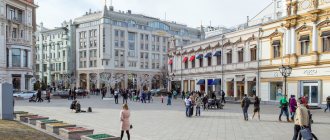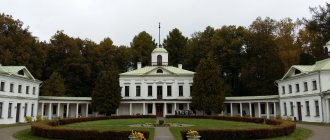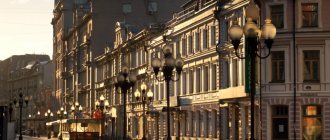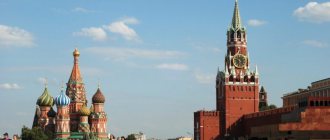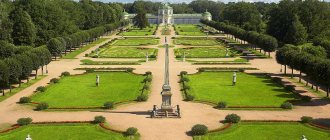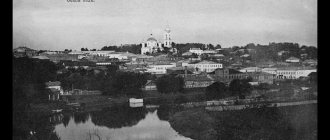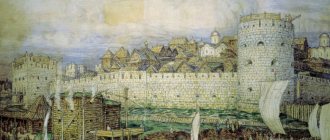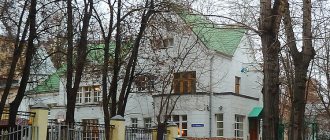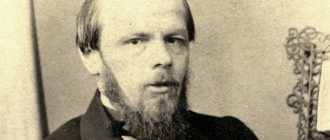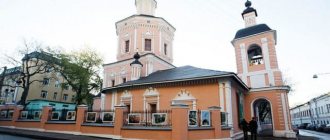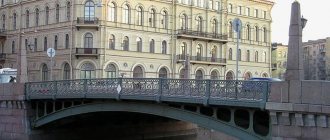The house-museum of Bulat Okudzhava is located in the famous writer’s village of Peredelkino, located in the southwest of the Russian capital. The dacha town became famous far beyond its borders thanks to the famous names of writers and creative people who lived here in different periods, starting from 1935.
In 1988, the authorities of the Moscow region were forced to assign the village the status of a cultural and historical reserve in order to avoid its demolition due to the expansion of the boundaries of the metropolis. This resolution made it possible not only to save Peredelkino, but also to officially establish the house-museums of Korney Chukovsky and Boris Pasternak. The Okudzhava Museum appeared here exactly 10 years later. Today it hosts literary and creative evenings, meetings and excursions, organizes concerts, film screenings and master classes.
House-Museum of B. Okudzhava in Peredelkino, © Anna Abrosimova
According to the guests of Bulat Shalvovich’s dacha, they come here for happiness, warm communication and friendly cohesion. This amazing island of poetry and music radiates nobility, conscience, dignity and genuine love for the Fatherland. This is what fans of the famous singer-songwriter think.
Sights of Peredelkino
Now Peredelkino's attractions include memorial museums of writers and poets of the 20th century, Tsereteli's workshop, Yevtushenko Gallery, Peredelkino cemetery and other historical and cultural monuments.
Peredelkino is part of the village of DSK "Michurinets", located in the Novo-Peredelkino district of Moscow. Near the writers' village there are the Peredelkino and Michurinets railway platforms in the Kyiv direction.
How to get there
Electric trains run from the Kievsky railway station in Moscow to the Michurinets railway station on schedule. Next - on foot according to the scheme presented below.
You can get to Peredelkino by car along the Minskoye or Borovskoye highways. In the first case, turn left into the village. Bakovka on Budenovskoye Highway. In the second case, you can get there through Novo-Peredelkino, turning right onto 9th Chobotovskaya Street and crossing the overpass over the railway track.
All popular taxi apps work in Moscow - Gett, Yandex.Taxi, Uber, Maxim, RuTaxi (Lucky).
House-Museum of Bulat Okudzhava:
House of Writers' Creativity
The first House of Writers' Creativity in Peredelkino opened in the late 1930s at the address: Vishnevsky Proezd, Dacha No. 1. However, it did not exist here for long; already in the 1950s, a new dacha was built on this site, the last occupant of which was the writer Mikhail Alekseev.
The main building of the modern House of Writers' Creativity appeared in 1955, and it was fenced off in such a way that several writers' houses that stood nearby also entered its territory and turned into outbuildings.
In the 1970s, a “glass building” was added to the skeleton of the building, which housed a dining room, an assembly hall, a library, a bar and a billiard room. In the 1980s, the House of Creativity had another building with numbers. In the Soviet years, it was possible to get to the House of Writers' Creativity only through the Literary Fund, but since the early 1990s, anyone can relax there.
In August 2021, it was decided to resume the creative residence of writers at the House of Creativity.
Suburbia for Soviet writers
According to legend, the creation of the writers' town was initiated by Maxim Gorky. He told Stalin about country residences in Europe and suggested a location for future construction. Work began in 1933 - the German Ernst May, who was involved in standard development in Kharkov, Orsk, Novokuznetsk, Kemerovo and the cities of the Urals, was appointed chief architect of the project. According to the original plan, 90 houses with all amenities and infrastructure were to be built in Peredelkino, but the budget turned out to be too large, and only 30 were built. In 1935, the Literary Fund of the USSR began to rent out the first houses. Agreements with residents were concluded for life; relatives had no rights to further residence in the buildings in the event of the death of a cultural figure.
Houses built on swampy soil often flooded, and the walls and windows were not insulated, so at first the writers spent only the summer months in Peredelkino. Many people repaired buildings on their own. The first inhabitants of the writer's suburbia were Leonid Leonov, Korney Chukovsky, Lev Kassil, Boris Pasternak, Ilya Ilf and other writers. Relatives of writers still live in many houses.
After the collapse of the USSR, part of the village’s property was privatized, and part went to the All-Russian Literary Society. The owners of many houses have not yet been identified - trials are ongoing. Today, realtors call Peredelkino a typical elite village. Along with ordinary modern houses, writers' houses are periodically put up for sale. The price of real estate in Peredelkino can reach up to a billion rubles.
Chukovsky House-Museum
Website: goslitmuz.ru Address: Moscow, pos. Vnukovskoye, village DSK "Michurinets", st. Serafimovicha, 3. Opening hours: from 11.00 to 18.00 (ticket office until 17.30), closed on Monday. Ticket price: 200 rub.
The famous children's writer lived in Peredelkino from 1938 until his death in 1969. Daughter Lydia and granddaughter Elena preserved the furnishings in the house as they were during the writer’s lifetime. Initially, the museum existed unofficially, and excursions around it were conducted by relatives of Korney Ivanovich. The memorial museum received its status only in 1994. At the same time, Lev Shilov, an outstanding Russian literary critic, became its first director.
The museum's exhibition consists of photographs from his personal archive, graphics and paintings that recall the connection of Korney Chukovsky with major figures of Russian culture of the early 20th century: V. Mayakovsky, A. Blok, I. Repin, L. Andreev, B. Grigoriev, A. Akhmatova and A. Solzhenitsyn.
Among the exhibits in the museum you can find the robe of the Oxford Doctor of Literature, gifts to the writer from children and adults from Russia, Japan, America, and England. In addition, a significant part of the exhibition is occupied by the writer’s library: it consists of about 4.5 thousand books, including more than a thousand in foreign languages.
Near this landmark of Peredelkino there is a bonfire site, where “Bonfires” are still held to this day - summer holiday events for children, invented by Chukovsky, in which writers, actors and singers participate. In past years, A. Barto, B. Zakhoder and A. Raikin performed here for the children. At this time, Korney Ivanovich put on an Indian costume and was on the site as a spectator.
Alla Gerber
writer, film critic, social activist
“I started going to the Peredelkino House of Creativity in the mid-70s. We all basically huddled in the old building then. A new one, made of brick, was built later. There were also cottages on the property where some of us lived in separate rooms. Everything is on vouchers. The old building had small cabin-like rooms and one toilet per floor. There was a large dining room, the tables were covered with oilcloth, but the same waitresses were sweet, kind, family-oriented, year after year, always trying with their kindness to make our tasteless food tastier. However, it was not so tasteless: over time, good housewives and cooks appeared. I will never forget their homemade buns and really grandma’s pancakes. In the dining room, there was a fight among the young people for tables - to sit with popular and beloved writers.
Of course, Soviet writers lived and worked in Peredelkino. But in the ideological sense, those in whose circle I was, were not “Soviet”. They were simply good writers, and by their convictions they were outside the regime or in opposition to it. Among them were Fazil Iskander, Grisha Gorin, Misha Kozakov, Misha Roshchin and many others. Peredelkino served as a home place for all of us, where we could gather or meet a familiar face at any moment. This was our home, where everyone belonged and we could talk about everything openly. This was our internal emigration. Probably, there could be informers among the residents, but we didn’t care, we weren’t afraid.
Here many wrote the first and last pages of their famous books. I remember one late night in the cottage where Volodya Voinovich lived, I heard the first pages of his subsequently world-famous “Chonkin,” which he wrote that same day. Tolya Pristavkin in Peredelkino read to us the manuscript of his great story “The Golden Cloud Spent the Night” - about his wartime childhood and Stalin’s eviction of entire peoples of the Caucasus. On Peredelkino evenings, everyone read their poems or stories, some of which were never published, often for censorship reasons.
Many writers lived not in the House of Creativity itself, but in their Peredelkino dachas, including Okudzhava, Bella Akhmadulina, Fazil Iskander, whom I regularly visited, and then Vasya Aksenov, from where we saw him off when the authorities escorted him out countries for the Metropol magazine. Many years later, I met Aksenov in Washington - the first thing he said was “And now, probably, everyone is sitting at Bulat’s.” That’s how it was - we often gathered at Bulat’s.
You need to understand that the history of Peredelkino is not limited to the “sixties”. The fame of this village was brought primarily by the first generation of Soviet writers of the pre-war era - the time of the emergence of the village itself. It was then that Pasternak, Chukovsky, Kataev, Lavrenev, Kaverin, Fedin, Fadeev and many others settled here.
Naturally, Peredelkin's writing environment was not homogeneous. There were people like us, conventionally liberal, and there were completely different ones - such generals from literature, functionaries from among the so-called classics like Anatoly Ivanov, Safronov. Now few people remember their names or works. But then these functionaries had a privileged position and enormous weight. They usually lived in their large dachas behind high fences. The fates of other writers were often in their hands. Some were forced to leave the country not without their help, for example Vladimir Voinovich, Vasily Aksenov and Alexander Solzhenitsyn.
The Peredelkino era lasted almost 10 years after the collapse of the USSR. In the 90s, people continued to come, work and communicate. The menu remained unchanged. Then everything calmed down - primarily because those people who created Peredelkino with their presence, thoughts and jokes gradually disappeared. The buildings of the House of Creativity have always belonged to the Literary Fund. The new, already Russian, Literary Fund turned the House of Creativity into an income source - a hostel, a hotel.
I don't think anyone in today's generation could or would want to recreate that lifestyle. The life of writers has ceased to be as collective as it was in creative houses.”
Pasternak House-Museum
Website: goslitmuz.ru Address: Moscow, Vnukovskoye settlement, village. DSK "Michurinets", st. Pavlenko, 3. Opening hours: from 11.00 to 18.00 (ticket office until 17.30), closed on Monday. Ticket price: 200 rub.
Boris Leonidovich lived in Peredelkino since 1936, but only in 1939 did he move to a country house, the building of which now houses a museum. It was here that he wrote the book Doctor Zhivago, translated Goethe's Faust and Shakespeare's plays, and also completed writing several cycles of poetry.
Guests included Anna Akhmatova, Korney Chukovsky, Pyotr Kapitsa, Evgeny Yevtushenko, Andrei Voznesensky, and Olga Berggolts. It was here that Pasternak received the news that he had been awarded the Nobel Prize in 1958, because of which persecution began against the writer. He died there in 1960, after which he was buried in the Peredelkino cemetery.
The family preserved the house for many years and honored the memory of Pasternak, although the authorities for a long time prohibited the publication of his work and refused to create a memorial museum at the dacha. However, in 1990, in the year of the 100th anniversary of the birth of Boris Leonidovich, declared by UNESCO as the year of Pasternak, the museum was finally opened. Its first director was N. A. Pasternak, the writer’s daughter-in-law, and after her death, E. L. Pasternak, the granddaughter of Boris Leonidovich, was appointed museum curator.
Cafe "Peredelki" and Samarinsky Pond
Odintsovo district, village. Peredelki, 81
Instagram
To relax, go to the cafe next to the Samarinsky Pond. Here you can have lunch and drink coffee, and then go to the pond nearby. The territory adjacent to the Samarinsky Pond was going to be improved. Several years ago, residents of Peredelkino turned to the local administration with a request to build an embankment and received a positive response.
After some time, sketches of possible improvements appeared, but then the process stopped. There is no exact information about the start of work.
Okudzhava House-Museum
Website: okudshava.ru Address: Moscow, Vnukovskoye settlement, village. Michurinets, Dovzhenko street, building 11. Opening hours: from 11.00 to 17.00, closed on Monday. Tours are held at 11.00, 13.00 and 15.00. Ticket price: 150 rub.
In the summer of 1987, Bulat Okudzhava received a dacha in Peredelkino for rent from the Writers' Union, where he lived surrounded by his friends and literary fellow tribesmen for ten years, until his death.
The idea of creating a museum in the Peredelkino house arose immediately after the news of his death, and in August 1998 the Bulat Okudzhava Folk Museum in Peredelkino opened here. A year later, thanks to a presidential decree, it turned into the Federal State Memorial Museum of Bulat Okudzhava.
The house-museum is divided into two parts, the first of which is entirely dedicated to the Soviet bard. This exhibition allows you to view Bulat Shalvovich’s personal belongings, archives, audio and video recordings. Souvenirs and paintings are also placed here - gifts from artist friends, as well as the poet’s famous collection of bells.
The second part of the Peredelkino attraction is called the “Museum for Friends.” Festivals, scientific conferences, creative evenings are held here, as well as the famous “Bulatov Saturdays”, where poems, original songs and classical music are performed.
Prices
The cost of a full entrance ticket is 150 rubles, a discounted ticket is 100 rubles. The following people can visit the house-museum for free:
- children under 16 years of age;
- members of large families;
- WWII veterans;
- combatants;
- liquidators of the Chernobyl accident;
- disabled people of groups I and II;
- illegally repressed;
- employees of museums of the Russian Federation and members of ICOM;
- heroes of the USSR, Russian Federation and full holders of the Order of Glory.
Excursions are paid additionally (in rubles):
- individual - 500;
- team up to 5 people - 300 each;
- group for 6–12 people - 250 each;
- for an organized group of no more than 12 people. — 3000, up to 15 people additional 250 per person.
There are no benefits for creative evenings, film screenings or concerts. The cost of visiting them is usually 300–400 rubles.
Panorama of Okudzhava's house from the street. Marx:
Yevtushenko Museum-Gallery
Address: Moscow, Vnukovskoye settlement, pos. DSK Michurinets, st. Gogolya, 1A
The official opening of the Yevgeny Yevtushenko Museum-Gallery took place on the eve of his birthday, July 17, 2010. The Russian poet and Nobel Prize nominee himself built a two-story building and purchased exhibits for it, and then donated them, along with a plot of land, to the state.
On the lower floor of the gallery there are three interconnected halls. The first of them houses the photo exhibition “My Humanity,” which includes about three hundred photographs of Evgeniy Alexandrovich taken during his travels. The exhibition in the second hall “My Abroad” offers paintings by foreign artists of the 20th century, including Picasso, Léger and Marc Chagall.
In the third exhibition hall there is an exhibition of Soviet artists “I was born in the USSR...”, most of which are avant-garde artists: Y. Vasiliev, S. Moiseenko, A. Bibin, M. Shemyakin, T. Shevchenko, O. Tselkov and others.
On the second floor of the Museum-Gallery there is a library and an office where you can see the personal documents of Yevgeny Yevtushenko. Also displayed here are posters, posters and photographs of the poet’s meetings with his friends and famous figures of the 20th century: Gabriel Garcia Marquez, Arthur Miller, Fidel Castro, Heinrich Böll, Robert Kennedy, John Updike.
Museums and memorable places of Arbat
House of Bulat Okudzhava and monument to Bulat Okudzhava
Address: st. Arbat, 43; Plotnikov Lane, 21, building 1 Telephone: Website: https://www.okudshava.ru Opening hours: Wed-Sun 12:00 - 19:00 Cost: adult - 300 rubles, reduced price - 200 rubles.
The house has existed on Arbat since the mid-19th century. It was originally two-story. In the 20th century, two more floors were added to the building and it was expanded deep into the courtyard, turning it into an apartment building.
After the revolution there were communal apartments here. Bulat Okudzhava spent his childhood in one of these apartments.
In 2002, a monument to the famous bard appeared on the corner of Arbat and Plotnikov Lane. This is a whole sculptural composition in the form of a piece of a Moscow courtyard with the figure of Okudzhava and arches covered with quotes from the poet in the style of courtyard inscriptions.
The authors of the work are sculptor Georgy Frangulyan, architects Igor Popov and Valentin Proshlyakov.
Behind the monument there is a cultural center called “Bulat Okudzhava’s House”.
People come to the concert hall of the center to meet with actors to listen to a story about the art of the 20th century. Children are brought here to puppet theater performances and various master classes.
There is also an exhibition hall in the center. Temporary exhibitions are held here. For example, Irina Andreeva’s exhibition “Warm Day”. It's quite small. About 10 works using the technique of wet felting from wool are presented. The exhibition is dedicated to the simple joys of home life, consisting of a series of stories from one day from childhood in the parental home.
Memorial Museum-Apartment of A.S. Pushkin. House Khitrovo
Address: st. Arbat, 53 Telephone: Opening hours: Wed-Sun 10:00-18:00, Thu 13:00-21:00
In this house, Alexander Pushkin rented an apartment from the Khitrovo nobles. A “bachelor party” was held here before the wedding, and Pushkin came here with his young wife after the wedding.
The opening day of the museum is dedicated to the 155th wedding anniversary of Alexander Pushkin and Natalya Goncharova - February 18, 1986.
The entire mansion has been given over to the museum. They tried to recreate the atmosphere of the 19th century. The Pushkins' living rooms are located on the second floor. They feature items belonging to Pushkin's descendants.
Memorial apartment of Andrei Bely
Address: st. Arbat, 55/32 Phone: Website: www.pushkinmuseum.ru Opening hours: Wed-Sun 10:00-18:00, Thu 13:00-21:00 Cost: 100-250 rubles, third Sunday of the month - free
A century and a half ago, families of professors from Moscow University lived in the house. On the third floor was the apartment of the mathematician Nikolai Vasilyevich Bugaev. Boris Nikolaevich Bugaev, the symbolist poet Andrei Bely, was born in this apartment in 1880 and lived in it for 26 years. It is this apartment and its guests that are described in the author’s autobiographical prose works.
The exhibition includes the writer's belongings, books, and drawings.
Moscow Museum of Perfumery
Address: st. Arbat, 36/2, building 1 Phone: Website: https://museumperfume.ru Opening hours: Mon-Sun 12:00-20:00 Tasting cost: 1500 rub.
Private charity museum. Founded in 2011. Occupies a manor house from the early 20th century. The museum's fragrance library, the osmotheque, numbers about 60 thousand items. The rotating exhibition consists of 1500-2000 bottles. Despite their venerable age - the oldest sample is 150 years old - all fragrances are in perfect reference condition.
The museum's collection began with a private collection of antique and vintage fragrances from the family of the museum's founder. The format of excursions around the museum is tasting and tea drinking.
Particularly valuable bottles are opened only on pre-planned days.
A most interesting event takes place in the museum on Moscow City Day and on International Museum Night: vintage perfumes fill the perfume fountain. Access to this performance is only possible by appointment several months in advance. The museum has a “Collectors Club” for connoisseurs and vintage lovers. Vintage perfumes can be purchased in the museum shop. There are no modern perfumes.
The museum is small. It is better to arrange a visit in advance. You can also organize a romantic date within the walls of the museum. The script will be developed to suit individual preferences.
State Museum of Konstantin and Viktor Melnikov
Address: Krivoarbatsky lane, 10 Phone: Website: https://muar.ru/new/dom-melnikova Cost: excursion ticket - 700 rubles, discounted ticket - 350 rubles. Opening hours of the museum courtyard: Mon-Sun 10:00-19:00 Excursion: Tue-Sat at 12:00
House-workshop of the architect Konstantin Stepanovich Melnikov. An example of the Soviet avant-garde. Built with the owner's personal funds.
The very fact of building a private house in the center of the capital during the times of communal apartments is surprising. There are several explanations for this
- The house was officially recognized as an experimental structure.
- Konstantin Melnikov had worldwide recognition. He built the USSR pavilion for the Paris International Exhibition.
- The architect is credited with the authorship of Lenin's first sarcophagus, and the land plot is a reward for his work.
The current technical condition of the house is deplorable due to lack of repairs for many years.
Half of the house belongs to the state, half to the architect’s heirs.
Since 2014 there has been a museum here. The visit is provided only as part of an excursion group of 5 people. The excitement is great. Sign up a month in advance. Registration on the website begins on the 1st of the previous month.
Wall of Viktor Tsoi
Address: st. Arbat, 37/2
It is a wall of a building with inscriptions and drawings dedicated to Viktor Tsoi.
The first inscription was made after the death of the singer. Then one appeared that became the slogan of the fans - “Tsoi is alive.”
Fans of the musician’s talent gathered near the wall, brought flowers, and wrote on the wall. There was a tradition of leaving a broken cigarette in memory of Viktor Tsoi.
In 2006, all the writing on the wall was painted over at night. Fans of the Kino group used photographs to restore the wall to its original appearance.
Zurab Tsereteli Museum-Workshop
Address: Moscow, Vnukovskoye settlement, pos. DSK Michurinets, st. Lermontova, 1.
In the 1990s, sculptor Zurab Tsereteli acquired the former dacha of the French artist F. Léger in Peredelkino. Even then, there were two houses on the territory, which were later converted into a creative workshop and a sculpture garden.
In 2021, the opening ceremony of the new Zurab Tsereteli Museum-Workshop took place here. His concept was based on the dynamics of the creative process and the movement of the author’s thoughts. Exhibitions in the gallery change periodically, but among them you can see bas-reliefs of biblical scenes, sculptural portraits of cultural figures, and fragments of mosaic panels.
And on the streets of Peredelkino, tourists often have the opportunity to meet the owner of the workshop, who often works here, walks along the paths of the park, communicates and takes photographs with visitors.
Way back
I decided to return to Moscow by taxi. The streets of Peredelkino are so quiet and deserted that it is difficult to imagine cars or any other attribute of big city life here. The only sounds here, besides birds, are the creaking of pine trees and the sound of an electric train in the distance. And so it has been for many decades - everything is calm and unchanged.
For such a place isolated from the city, the taxi arrives unexpectedly quickly. Just five minutes later I was already driving in a dense stream of cars on a polluted highway. Supermarket signs glittered on the sides, and dozens of people stood crowded at bus stops. From a quiet, thoughtful world, in a matter of minutes I found myself in the familiar bustling capital. Now, when I want to put myself into a state of peace, I close my eyes and imagine the creaking of Peredelkino trees. And somehow it immediately feels good.
Photo: Artem Chernov
Peredelkinskoye Cemetery
The grave of Boris Pasternak
The memorial cemetery arose near the village of Lukino around the 17th century and was previously an ordinary village cemetery. However, the appearance in 1934 of the dacha village of Peredelkino nearby turned the cemetery into one of the most famous literary necropolises in the country.
At the moment, outstanding writers Boris Pasternak, Korney Chukovsky, Arseny Tarkovsky, Robert Rozhdestvensky, Yevgeny Yevtushenko, as well as director Andrei Tarkovsky are buried here. Other famous cultural figures, Heroes of the Soviet Union and Socialist Labor are also buried here.
Lukino Estate (residence of the Patriarch)
Not far from the Peredelkino cemetery there is the ancient village of Lukino, which was first mentioned in scribe books of the 16th century. Its main architectural attraction is the estate, which is a monument of the 18th century, built by Prince Mikhail Dolgorukov in 1729. Subsequently, Princess Agrafena Dolgorukova became its owner, and then Countess Varvara Razumovskaya, who built the stone Church of the Transfiguration of the Lord next to the house in 1819.
The last owner of the Peredelkino landmark was Baron Mikhail Lvovich Bode-Kolychev, who lived here at the end of the 19th century. He was a representative of the ancient Kolychev family and the custodian of the family heritage, he was very interested in the history of his family, and therefore decided to make a real museum out of the estate.
In the 60s of the 19th century, he built a new house in the pseudo-Russian style on the estate. Its architect, artist and designer was the famous academician and professor of the Imperial Academy of Arts Fyodor Solntsev. In 1884, an obelisk appeared in the courtyard of the estate, next to the house there was a special storage room for the family archive, and not far from the temple there was a chapel in honor of St. Philip. In the 10s of the 20th century, next to the mansion, the Church of the Transfiguration was also erected in the Empire style, which contained elements of the styles of the 16th and 17th centuries.
After the revolution, the Lukino estate was destroyed and transferred to the state farm, but already in 1952 its main house was given to the Moscow patriarchs. To this day, the territory of the estate belongs to the temple and is not accessible to ordinary tourists. The Patriarchal courtyard was built on it, due to which new buildings appeared in the residence, for example, the Patriarchal Palace and others.
Church of Igor of Chernigov
Address: 7th Lazienki Street, 42B.
The Church of St. Igor of Chernigov in the neo-Russian style was built in 2013 on the initiative of Patriarch Alexy II. For the construction of this Peredelkino landmark, the famous architect Alexander Shipkov received the “Golden Sign” award of the XXII International Festival “Architecture-2014” in the “Public Building” category.
The temple is based on St. Basil's Cathedral on Red Square. The multi-colored domes are made of porcelain using original technology. In front of the temple there is a monument to Prince Igor of Chernigov and a monument to Metropolitan Philip.
The church is located near the residence of the patriarch and the Peredelkino railway station.
